By Michael S. Slocum
Life in space and under water are complex environments requiring precision in regularly changing situations. TRIZ has proven an important tool in making life more reliable and predictable in unstable and changing locations.
Systematic Innovation and the International Space Station
Designing and manufacturing the complex systems for the international space station involved enormous effort. There were a large number of problems that needed to be solved on a routine basis. The complexity of the effort was enhanced because of schedule delays and other logistical problems that enhanced the pressure the teams worked under. In many cases, the typical compromise solution would not meet the strict performance requirements the system demanded. The Theory of Inventive Problem Solving (TRIZ) was useful in resolving many of the most difficult issues.
The Pressurized Mating Adapter
The demands placed upon the various systems that needed integration were vast. Interface requirements were critical and the performance of the station as a whole depended on each individual interaction functioning exactly as required. Each module was attached to the next using a pressurized mating adapter (PMA) whose structure and function had to be precise and perfect – the integrity of the station depended on this. There were many manufacturing challenges associated with this important functional unit.
| Figure 1: Pressurized Mating Adapter |
| 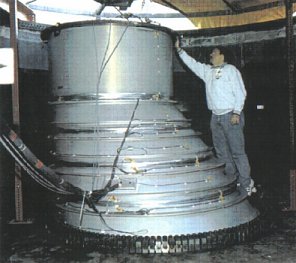 |
|
|
As Figure 1 shows, the PMA is larger than the size of an average man. The tolerances and geometry needed to be precise over the full length of the device; this presented a number of manufacturing and measurement problems. TRIZ was used to create solutions for the assembly of the PMA. The various structural rings of the PMA needed to be welded together, but the heat required during the welding process was such that it could damage associated – and sensitive – electronics. Innovative isolation techniques were created to adequately protect these components from the heat. Also, measurement techniques were developed that would insure proper alignment between two modules when installed in orbit by the astronauts. These techniques were not only reliable, but also reduced inspection time significantly.
The solar panel array posed a variety of complex problems as well. The sheer size of the structure posed problems. The surface finish on each piece of the mirrored tiles had to be near perfect. This created manufacturing, assembly and quality assessment issues. Assembling each of these panels into the overall structure posed difficulties, too. TRIZ helped develop assembly techniques that protected the pieces in place during the addition of others. This technique sped assembly while minimizing the risk of damaging other panels. Surface quality measurements for each panel where needed as well. Surface quality in a panel, as well as surface quality across many panels, was required to ensure proper and safe function in orbit.
| Figure 2: Solar Panel Array |
| 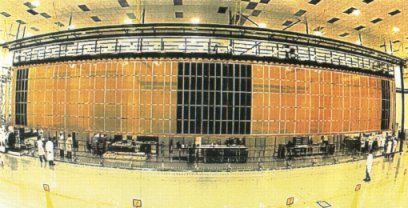 |
|
|
Another space station component that benefited from the TRIZ methodology was the utility rail. The utility rail is the electro-mechanical device that interconnects each module of the assembled space station. Power and signal are distributed through the utility rails throughout the station.
| Figure 3: Node 1 Utility Rail |
| 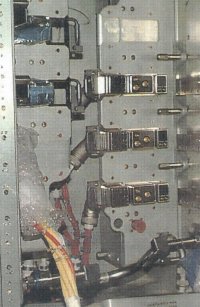 |
|
|
A number of issues were resolved in the utility rail system. Astronauts need to be able to assemble various connector configurations in space. In order to make this process achievable, despite the demands posed by the extra-vehicular environment (EVA), an innovative insertion and locking mechanism was needed. TRIZ was used to solve this problem – a reliable interlock while minimizing EVA assembly difficulty.
A positive mate marker was required for rotational connection devices. This marker was placed on the device using paint. The paint, however, deteriorated when exposed to diatomic oxygen. TRIZ and robust design were used to create an innovative solution and to optimize the application method.
There were also several assembly issues that needed to be addressed at the component level. The station, at low earth orbit, will accumulate a plasma field. This field could cause electrical problems for signal and/or power transmission. Insulating devices were employed in the original design as a way of precluding this failure. However, molded knit-lines, porosity and gaps in the bond interface created opportunities for failure. TRIZ was used in each case to create a dielectric barrier that would prevent any failures by these modes.
The international space station is in orbit now and benefited from more than 100 problems being solved using the TRIZ methodology.
Figure 4: International Space Station in Orbit
as Seen from Space Shuttle Atlantis |
| 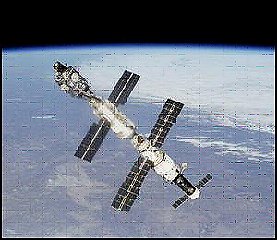 |
|
Photo by NASA |
Systematic Innovation and the Seawolf Submarine
The Seawolf submarine uses advanced technology for its passive sonar capabilities. The core of the technology is the sonar array that is utilized for signal processing. These two spheres (one fore and one aft) are covered in hydrophones. These are piezoelectric devices that convert pressure into an electric signal. These hydrophones need to be submerged in water during operation and are, therefore, subject to extreme environmental conditions.
Figure 5: Seawolf Submarine and
a Passive Sonar Array |
| 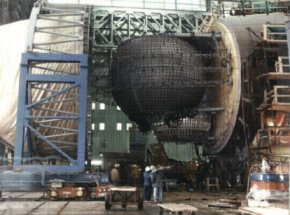 |
|
|
Each hydrophone is attached by a cable to a sub-assembly connector that routes 8-16 hydrophones to a signal processor. Each hydrophone needs to be hermetically sealed from one end to the other. The massive number of hydrophones provided a large number of failure sites. An innovative manufacturing technique, therefore, needed to be developed to ensure that seawater was kept out of the hydrophone sub-systems as well as the signal processing system.
| Figure 6: Sonosphere and Hydrophones |
| 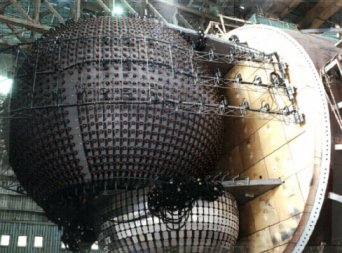 |
|
|
A technique was developed that would melt the protective layer covering the signal transmission system of one hydrophone (together with seven others) into a single hermetic covering – entering the back of the signal processing system interconnect. This was performed using an extrusion mold with multiple zones. The existing coverings were able to be heated and fused in a new coating that was surrounded by extruded polymer, and then transitioned to the new composite device. This process proved to be reliable and successfully solved many problems.
Conclusion
The value of TRIZ is demonstrated in small projects as often as it is demonstrated in large projects. One project can have numerous problems with one inventive solution that can lead to more opportunities for ideality. When it happens on grand scales such as described above, the effects may seem more exciting, but that should not stop anyone from solving everyday challenges with the power of TRIZ.
About the Author:
Michael S. Slocum, Ph.D., is the principal and chief executive officer of The Inventioneering Company. Contact Michael S. Slocum at michael (at) inventioneeringco.com or visit http://www.inventioneeringco.com.
Copyright © 2006-2011
– RealInnovation.com, CTQ Media. All Rights Reserved
Reproduction Without Permission Is Strictly Prohibited –
Request Permission
Publish an Article: Do you have a innovation
tip, learning or case study?
Share it
with the largest community of Innovation
professionals, and be recognized by your peers.
It's a
great way to promote your expertise and/or build your resume.
Read more about submitting an article.